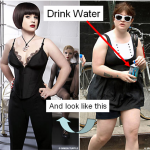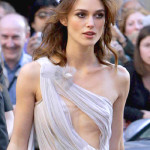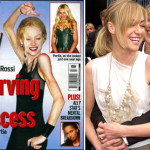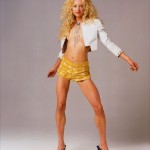
This article gives new meaning to the terms “Brick House” and “Pain in the Ass!”. We all know that the world is been effected by an ass fetish. Back in the 80’s and early 90’s women (especially white women) were getting down with Jane Fonda, fast walking and tread-milling furiously to keep their hips and behinds flat and lean. Black women (and men) on the other hand have always embraced the booty, the bigger the better. In African American and Latino communities a young girl can be chastised if when she starts to get her breasts her behind does not fill out as well. For brown girls there is nothing worse than a flat ass, you can not have breast but, to be assless is… almost shameful.
Well in the late 90’s white women (and men) caught on to the craze, with both the lips and the booty. My theory has me thinking that when silicon injectables became more commonplace (and affordable) more women began to seek out that bee-stung pout and perky backside. The Brazilians and the Argentinians have also been way ahead of us when it comes to plastic surgery and implants (plus they are a both cultures that are extraordinarily body aware- and they wear less clothes at times!). Butt–pun intended, the craze morphed into a fetish in with the millennium, the world seemed to have ass envy. All those white women jumped off of their treadmills and started doing squats with J-Lo to Kim Kardashian’s pictures as body role models. As always when there is a high end procedure that is available to the wealthy, it begets the backstreet bootlegger who will promise those on a budget the same results for less. But as always…you get what you pay for. I think we were all shock by the transexual in Oneal Ron Morris who was arrested for doing butt implants using cement, fix-o-flat, car oil, and crazy glue!! No one in their right mind could imagine that someone would allow their bodies to be injected with such things, but sadly this has now become a common thing.

Mug shots of Oneal Ron Morris, a.k.a. the Duchess, illustrate her transition. “She had the perfect body,” a friend said. “But she took it too far.” Photos provided by the Broward County Sheriff’s Office
I found this article recently that takes a very raw look at the issue. please take note that some of the language and photos are graphic but it is completely mind blowing!

Buttloads of Pain
Illegal Ass Enhancements May Be America’s Next Health Epidemic
By Wilbert L. Cooper
The horror that befell Oscarina Busse’s backside began in July 2009. The 35-year-old Floridian felt a dull but persistent itch deep in the meat of her buttocks, one that was impossible to scratch.
It wasn’t long before Oscarina noticed that her butt was changing colors—first turning purple, like a throbbing finger that had been wrapped too tightly with string, and then a cadaverous gray. From there, things got much worse. Her flesh started to crust and painfully peel off until, a few months later, the whole mess collapsed like a badly baked cake. The cheeks of her ass drooped down, loaded with a stew of poisonous goop that collected around her lower buttocks. What had once stood high and felt supple to the touch had become hot and hard and stinging. Oscarina’s derrière had transformed so much that it no longer looked like it was part of a human’s body; her five-year-old daughter mistook her fluid-filled cheeks for a poopy diaper, calling it a “full Pamper.”
Like thousands of women across the globe and increasingly in the US, Oscarina was suffering from the side effects of a black-market butt injection. Because of its clandestine nature, it’s impossible to quantify exactly how many people in the US are illegally getting their butts pumped up like a pair of Reeboks. But the number is definitely growing; due to the proliferation of reported disfiguring cases like Oscarina’s and even deaths, law-enforcement officials and the American Society of Plastic Surgeons view black-market butt injections as a burgeoning epidemic in the US.
The crude inflation procedure consists of shooting a liquid substance such as silicone or mineral oil directly into a client’s butt cheeks and hips through a syringe. There is no substance that is safe to inject into your body to create more volume, not even medical-grade silicone, but these black-market “butt doctors” have, according to victims, allegedly used harsh substances like concrete and the industrial silicone sold at hardware stores in their procedures. After the injections, the exterior flesh wounds are sometimes closed with Super Glue to prevent the toxic slop from leaking out.
Anyone with a basic understanding of health and medicine knows that pumping someone’s body full of free-flowing substances like silicone is extremely dangerous. Hence it has been illegal to inject fluids like silicone into the body for cosmetic purposes since the late 60s, so these butt-pumping procedures are typically performed by back-alley quacks—rogue nut jobs with suitcases full of dirty needles and flasks full of muck. These procedures can trigger a strong autoimmune response as the body attempts to expel the foreign substance, resulting in inflammatory reactions such as polyps, boils, skin discoloration, and even necrosis. These substances have also been known to migrate through the body and fuse themselves to organs, or enter into the bloodstream, spreading infection throughout the body and causing septic shock—which can lead to the amputation of infected body parts or, in the worst cases, death.
In October, I met Oscarina at the beauty salon she owns in Coral Gables, Florida, to better understand why someone would inject their butt with toxic chemicals. She wore a form-fitting pantssuit, high heels that cackled against the salon’s linoleum floor, and a citrusy perfume that permeated the room as she paced back and forth from the shampoo bowls to her styling chair. Surprisingly, her butt seemed high and round. It looked pretty good, especially considering that only a few years ago her haunches had mutated into a distorted heap of poisoned flesh and immense pain.
Oscarina is lucky. She’s one of the few women who, after realizing something was very wrong with her new ass, managed to find a doctor who was willing to surgically remove the substances from her body and rebuild her butt, possibly saving her life in the process. She told me that the whole ordeal is something she feels gravely foolish about now, considering she was blessed with a shapely Dominican figure. But in south Florida, where gargantuan asses plop down every boardwalk and beach each minute of the day, just having a “nice butt” isn’t good enough for many. “No one [here] is ever happy with their body,” the beautician said to me sheepishly. “It wasn’t because I didn’t have it. I just wanted it to be better.”
Although it’s illegal to cram someone’s can full of mysterious substances, finding a butt doctor in the United States is like buying drugs; you just have to know a guy who knows a guy. These hookups happen through word of mouth, as well as via forums and social media sites. In Miami, America’s epicenter for clandestine butt surgery, it’s as easy as walking into a beauty spa where, among the massages, aromatherapy, and saunas, customers can allegedly order a bevy of illegal silicone butt shots off a secret menu.
So that’s exactly what Oscarina did, ordering her first set of injections at the beginning of the summer in 2002 for about $3,000. She wouldn’t tell me who had administered the procedure, but did admit that her clients recommended a certain spa in the area. She did it with the hope of getting her body in shape for bathing-suit season. She described to me the feeling of a syringe piercing deep into her butt and excreting as much as 600cc of industrial silicone simply as “filling,” as if her butt were a water balloon stretched over the nozzle of a garden hose.
Watch the trailer for Buttloads of Pain, airing next week on VICE.com.
It’s important to point out that there are legal butt-enhancing procedures. The FDA deems both implants and fat transfer—where fat is liposuctioned from areas like the patient’s stomach and transferred to his or her fanny—to be safe when conducted by a board-certified plastic surgeon. However, many women choose the black-market procedure to save money. Legal implants and fat transfers can cost up to $10,000 more than their illicit counterparts. For Oscarina, on the other hand, it was more about the shorter recovery time for injections than their lower cost. Fat transfer and butt implants require weeks of recuperation, and the final results don’t settle in for months. Injections result in a new rear end almost instantaneously, as if you’d put your backside in a butt microwave.
“The recuperation was very easy,” Oscarina explained. “I went to work right away. I just had to get a massage with the shots because, otherwise, it wouldn’t settle properly.”
It wasn’t until she decided to undergo another pumping procedure performed by a different spa in 2009 that everything went, quite literally, to shit. “I got the shots,” she told me as she ran a tail comb through the frizzy hair of a teenage girl, “and six months later my butt turned purple. The product had eaten off my muscle, and my skin peeled like an onion.”
It’s impossible to know what the problem might have been the second time around—it could have been the reaction between the new shots and the first round, or perhaps the new shots featured a lower grade of silicone that infected Oscarina’s ass. What we do know is that months after the second round of injections, Oscarina started to lose control of her body. But she was too embarrassed to talk to a doctor, even though her ass was rotting off.

Dr. Constantino Mendieta leans on his McLaren sports car—one of his many automobiles—in front of his massive Pinecrest, Florida, home.
It wasn’t until the winter that Oscarina finally shared her plight with anyone. Unable to bear the discomfort caused by her rapidly worsening deformity, she told me that she opened up to a client at her salon. She abruptly stopped doing the client’s hair and asked the woman to come look at her bare ass in the back room. Minutes later, under hot fluorescent lights, Oscarina pulled up her dress. In the vanity mirror, her painful secret was revealed in her client’s expression.
“When I saw her face, I knew it was terrible,” Oscarina said to me, staring off into the direction of the private room. It was at that moment that she knew she had to swallow her pride and seek real help.
Due to the challenge of reversing such a botched and unsanctioned operation and the resulting potential for legal liability, many doctors will not help a patient like Oscarina. Injected silicone can be corrosive and can easily migrate throughout the body. When it breaks down, which can happen in a matter of hours or over the course of several years, it becomes almost impossible to completely identify or locate. According to a comprehensive history of silicone injections in the US edited by Harvard Law professor Peter Barton Hutt, 555cc of silicone can break apart into 30 billion small globules once inside the body, and each of those 30 billion pieces has the potential to cause an infectious reaction. In other words, getting this stuff in your butt is easy—but to take it out involves getting carved up like a doner kebab.
“After going to consultations with doctors, their reactions made me think I was going to die,” Oscarina said. “I had this painful problem and nobody would touch me.”
Finally, after searching and searching for a doctor who would be willing to help her remove the silicone from her butt and speaking to a few more trusted friends, one of Oscarina’s clients who had been through a similar experience recommended Dr. Constantino Mendieta. The doctor agreed to fix her ass and, by her reckoning, saved her life.
“When I saw him,” Oscarina told me, “I saw the glory.”
The same week that I met Oscarina, I visited Dr. Mendieta at his practice in Miami’s affluent Coconut Grove neighborhood—a tan, stucco building with the words PLASTIC SURGERY inscribed on its façade. Dr. Mendieta is one of America’s top plastic surgeons, a sculptor of buttocks on par with Michelangelo whose book on butts, The Art of Gluteal Sculpting, was published in 2011. Unsurprisingly, the butt business has been very good to him. In the driveway sat his revved-up Maserati, which he told me is his beater for his work commute. When he’s not saving people’s asses, he whips around in a McLaren sports car.
“The buttock today is what the boobs were in the 60s,” Dr. Mendieta told me inside his office. His face looked like a Clark Kent mask, his skin pulled back at his temples, and he wore a royal-blue, custom-made admiral coat of fine Valentino silk. “But butts are better. When you look at breasts, you have to look at a face. There is no room to fantasize. But when you turn it around, there is no face anymore. You’re free to put whatever face you want on that booty.”
Even if Dr. Mendieta’s explanation was a little creepy, he is absolutely correct about the growth in popularity of butt augmentation among Americans. The number of legal butt procedures in the US increased by 176 percent between 2000 and 2012, exploding into a $26 million industry. Dr. Mendieta has been happily riding the crest of this ass wave. Ten years ago, 20 percent of his practice was the buttocks. Today, it’s 90 percent.
And while Dr. Mendieta would prefer to focus on molding new posteriors, more and more he’s been finding himself reconstructing the buttocks of women who’ve received black-market injections.
“There’s no question that I’ve been performing these reconstructive procedures at an increasing rate,” he said. He explained that he’s fixed about 30 illegally injected asses in his career, and five in 2013 alone. “People are coming to me from all over the world, mainly the United States. It’s endemic in South America, Miami, and New York, and some in LA. But Miami is a bigger hub for this stuff. My feeling is that I will see even a higher number in the future, because it can take five to ten years for the injections to react.”
Florida law-enforcement officials agree with Dr. Mendieta that cases such as Oscarina’s are an increasing problem. Detective Bryan Tutler of the Broward County Sheriff’s Office, who led the 2012 investigation of Oneal Ron Morris, one of the nation’s most notorious ass quacks, told me, “These things just started. If you go back three or four years, no one had ever heard of this. And now they’ve really picked up. Pretty soon, I don’t think that any law-enforcement agency is going to be able to hide from investigating these kinds of crimes.”
Which leaves Dr. Mendieta squarely on the front lines in the battle over illegal butt tampering—a battle that keeps getting worse. Of all the victims of illegal butt injections he’s operated on, he said that Oscarina’s was one of the most severe cases he’d ever seen.
“I had to cut a great deal of flesh out with the silicone,” he said, “because it had impregnated her tissue. We pulled out a pound and a half of pure, rock-hard substance from each cheek.”
The task of removing the damaged tissue and reconstructing Oscarina’s ass was such an undertaking that it had to be broken up into two operations. The $6,000 she spent on her butt injections no longer seems like a bargain; she estimates that it has cost her nearly $70,000 and counting to get her butt back into shape, and Oscarina still hasn’t undergone the second procedure in which the remaining impregnated tissue will be removed and her cheeks will be further fine-tuned. The truly sad thing is that she’s one of the lucky ones. There’s only one Dr. Constantino Mendieta, but who knows how many Oscarinas are out there suffering?

These images provided by Dr. Mendieta show complications from botched butt injections very similar to Oscarina Busse’s. You can see the discoloration throughout the buttock and the distorted shape. Like Oscarina’s, this butt was hard to the touch.
The use of silicone injections to increase the size of one’s assets is nothing new. The practice dates back to World War II, a hundred years after the synthetic compound was invented and a decade or so after it became commercially viable to mass produce. During the war, the US military used silicone to insulate electrical transformers. It was on the docks of Yokahama Harbor in Japan that American Army quartermasters first started noticing the relationship between their transformer insulation fluid disappearing and the increasing bust size of the local hookers. Although crude and certainly not medical grade, it was an ostensibly better option for Japanese sex professionals who up until that point had been pumping up their chests with paraffin and Vaseline.
American physicians started to take note of silicone as a breast augmenter. The practice of injecting silicone directly into the breasts spread throughout America in the 50s, 60s, and 70s, perpetrated by cosmeticians and plastic surgeons. Widely used by female entertainers, sex workers, and everyday women in the US—including Nancy Reagan—and it took some time before the horror stories of botched boob jobs bubbled to the surface of middle-class America. Over the years, many of these women suffered silicone cysts, collapsed nipples, and painful, rock-hard breasts.
In 1965, the FDA made it illegal for doctors without a special experimental permit to perform silicone injections—however, plastic surgeons kept pumping under the assumption that if they purchased the silicone made in their home state, they were operating outside the FDA’s jurisdiction. This continued until the practice started to fall out of favor in the late 60s and 70s due to countless horror stories and increasing regulations—states like Nevada and California made injections illegal in 1975, and several others followed suit.
With legal injections off the table, plastic surgeons turned to silicone implants, which were thought to be safer because the silicone was contained in an inert elastomer shell. However, due to studies linking implants to serious health issues, the FDA put implant manufacturers under a voluntary moratorium in 1992. In 2006 the FDA reapproved silicone-gel-filled implants, and they’ve since made a huge comeback, comprising 72 percent of all breast-augmentation procedures in the US in 2012. It was during the past two decades—when the country was engaged in a nationwide dialogue on the risks and benefits of implants—that silicone-injection procedures moved into the seedy underground.
Above all, it was the transgender community that really pioneered the backroom butt-injection scene in the 1980s and 90s. For a male transitioning to a female at that time, it was a ridiculous notion to think that insurance would foot the bill for procedures that made their outside look the way they felt on the inside. The black market was the go-to place for these types of augmentations because it was considerably cheaper. Also, at the time, the fat-transfer method had yet to be developed. To get the results that were desired—round, feminine butts—injections were the preferred option for many in the transgender community. After some of these women made their transitions, they turned around and became butt doctors themselves, using the injection technique that they’d utilized on their own bodies first.
Since then, the practice has moved from the margins toward the mainstream. One of the poster children for the horrible effects of silicone pumping is a woman from Los Angeles named Apryl Michelle Brown, whose lower legs and arms were amputated after her body went septic due to complications from silicone injections she received in 2004. Another high-profile victim was a 20-year-old woman named Claudia Seye Aderotimi. In 2011, she traveled from London to Philadelphia to get butt shots from Padge Victoria Windslowe, a transgender lady known in some circles as the “Black Madam.” Claudia was an aspiring dancer, looking to enhance her figure so she could make it in the hip-hop music-video scene. She died of a pulmonary embolism almost immediately after injections of industrial-grade silicone entered her bloodstream and traveled to her liver, lungs, and brain.
The phenomenon of butt pumping has even crept into popular culture. Every time Kim Kardashian or Jennifer Lopez wears a swimsuit, tabloids and gossip websites furiously debate whether their bodacious butts are the result of an intense squat regimen or ass injections. Former stripper and hip-hop model Vanity Wonder, who boasts ample 34-23-45 curves, wrote a book about her addiction to illegal butt shots and the 16-plus times she had her butt pumped up. Nicki Minaj, who is known for her huge rump almost as much as for her platinum-selling albums, has commented on the phenomenon of injections and admitted, albeit facetiously, that she’s had them done. In her guest verse on the remix of Big Sean’s “Dance (A$$),” Nicki raps: “Kiss my ass and my anus, ’cause it’s finally famous / And it’s finally soft, yeah, it’s finally solved! / I don’t know, man, guess them ass shots wore off!”
Continue reading after the Jump it gets better!!!

Corey Eubanks isn’t the slightest bit bashful about his illegal butt shots and the body they gave him. Here he is showing off his hams in a super low-cut wrestling leotard at Collins Park on Miami Beach.




 ‘Reverse retouched’: Cover girl Kamila was airbrushed to look healthier
‘Reverse retouched’: Cover girl Kamila was airbrushed to look healthier
 Skinny: Healthy magazine’s cover star Kamila as she appears normally
Skinny: Healthy magazine’s cover star Kamila as she appears normally







































